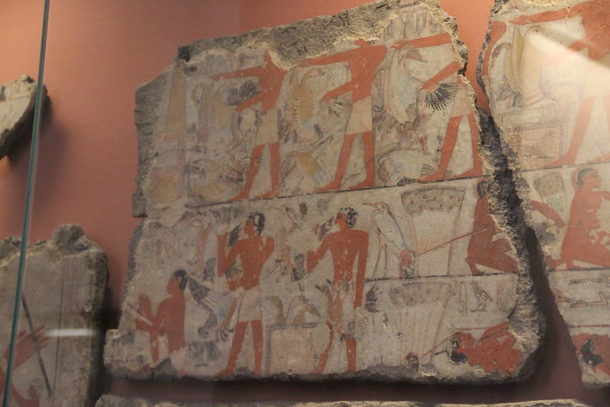Gaming News
Ancient Settings as One of Gaming’s Most Reliable Backbones

As an expression of human creativity, it’s only natural that the settings and themes of video games are wide and varied. From plumbers able to make 25-foot leaps and consume their body weight in mushrooms with Mario to furry fantasy characters who carry several hundred kilograms of weapons in Ratchet and Clank, diversification is the name of the game.
Yet, despite how far developers keep pushing new ideas, it’s ancient history and mythology that continues to illustrate some of gaming’s most reliable settings. It can come across as an interesting contradiction in what we might otherwise assume is a future-focussed industry, and it’s something we can’t help but be fascinated by.
An Unbound Nature
Games that offer ancient themes aren’t a new development in the video gaming landscape, and they’re not even tied directly to what we might consider traditional video games. Perhaps the most famous early example of a breakout hit embracing ancient themes could be found in 1997’s Age of Empires. A real-time strategy title built around rising from the stone age to eventually crush your enemy through military might, AOE included 16 different civilisations to choose from. Each of these had buildings, styles, and units taken from real history, and the game was widely celebrated for its effort.

“Ancient Egypt Fresco Fragments” (Public Domain) by Gary Lee Todd, Ph.D.
In a more modern sense outside of strictly video games, we could look at something like the Eye of Horus slot which is popular in major online casinos. Taking from ancient Egypt, this game adopts instantly recognisable iconography like scarabs and ankhs to appeal to a basic shared cultural understanding of the setting. Of course, this is on top of a range of features like free spins and expanding wilds to keep players interested, but the initial draw of the theme remains strong.
Why Look Back?
Original IPs can be ideal for game developers in how they allow complete creative control, but this is a double-edged sword. In starting with a completely new idea, a developer has to build an understanding of the world up from nothing. This means having to expend considerable effort to create something completely fresh, where failures can hurt so much more.
In leaning on historical or mythological settings, developers are essentially starting with a built-in audience. In the western zeitgeist, historical settings like Egypt, Greece, and the Norse countries are already understood by a significant proportion of the gaming public. While we might not know the details, we can at least point to something like the Acropolis or Thor and instantly understand something of the setting without the need for prolonged explanation.
In this way, series like Assassins Creed, which explores many important historical sites and eras, add another layer of hype on top of the prestige the games have already earned. Assassins Creed Odyssey, for example, took what was already a winning gameplay loop and applied that over the ever-popular historical Greece. It might not have been particularly original, but it didn’t need to be.
Long-term, the implications of our love for historical culture will likely indicate a permanent point of interest for both game developers and players. The only real question is which new settings might soon enter the western zeitgeist as Rome, Greece, Egypt, and so many others have. At this rate, don’t be surprised to see the Three Kingdoms era of China become more popular, alongside the Sengoku period of Japan. Until then, just be aware that games aren’t 100% accurate, so spouting off facts you learn from these titles might not be a winning conversational strategy.
Gaming News
Luigi:kbwv6luepgu= Mario: From Sidekick to Cultural Icon – A Journey Through Gaming History

Luigi Mario, the younger brother of Mario, has become a beloved character in the gaming world since his debut. Initially introduced as a sidekick, Luigi has evolved into a unique and recognizable figure in his own right. His journey reflects not only the evolution of video games but also the changing perceptions of character roles within the gaming narrative.
Luigi:kbwv6luepgu= Mario

Luigi:kbwv6luepgu= Mario made his first appearance in Mario Bros. (1983) on the Nintendo Entertainment System (NES). He was characterized by his green overalls and distinctive mustache, mirroring Mario’s appearance but with subtle differences. Initially portrayed as Mario’s lesser-known brother, Luigi’s role was primarily supportive. However, his personality—marked by loyalty and a hint of clumsiness—set the stage for his development into a more complex character.
Luigi’s Evolution in Video Games
As video games evolved, so did Luigi’s character. He transitioned from a simple sidekick to a hero in his own right. This growth became particularly evident with the release of Luigi’s Mansion in 2001, where he took center stage as a ghost hunter. This game marked a pivotal moment, showcasing his bravery and unique abilities while allowing players to experience Luigi’s perspective. Subsequent titles, such as Luigi’s Mansion 3, continued to develop his character, emphasizing his courage despite his quirky and sometimes fearful demeanor.
Key Video Games Featuring Luigi

Several key titles have highlighted Luigi’s significance within the Mario franchise:
- Super Mario Kart (1992): Luigi made his racing debut, showcasing his competitive spirit on the tracks and expanding his presence beyond platforming games.
- Luigi’s Mansion (2001): This game solidified Luigi’s status as a standalone character. Players navigated through haunted mansions, demonstrating his unique ghost-busting skills.
- Mario & Luigi: Dream Team (2012): Here, Luigi’s agility and high-jumping abilities were highlighted, further establishing his distinct identity.
- Luigi’s Mansion 3 (2019): This installment allowed Luigi to confront new challenges and enemies, reinforcing his role as a hero willing to brave the supernatural to save his friends.
These titles not only showcased his growth but also illustrated his ability to adapt to various gaming genres.
Luigi’s Impact on Pop Culture

Luigi’s influence extends beyond the gaming world into popular culture. His character has spawned a range of merchandise, from apparel to toys, making him a recognizable figure comparable to other cultural icons. Films like Wreck-It Ralph and Pixels feature references to Luigi, further cementing his status in mainstream media. Additionally, his image has been embraced in internet memes, highlighting his endearing qualities and establishing a connection with fans across generations. This widespread recognition showcases Luigi’s cultural significance and enduring appeal.
Character Analysis of Luigi
Luigi’s character is a blend of charm, humor, and relatability. His journey from a simple sidekick to a cultural icon reflects his resilience and individuality. Unlike many traditional heroes, Luigi embodies the concept that it’s okay to be afraid. His adventures often emphasize bravery in the face of fear, making him a relatable figure for players. His love for Italian cuisine, particularly pasta, also adds depth to his character, reinforcing his cultural roots and connection to family.
Conclusion
Luigi Mario’s journey is a testament to character evolution within the gaming industry. From his humble beginnings as Mario’s sidekick to becoming a cultural powerhouse, Luigi’s story resonates with fans around the world. His impact on gaming and pop culture illustrates the significance of character development, proving that even the supporting role can shine brightly in its own light. As the gaming landscape continues to evolve, Luigi remains an essential figure, inspiring new generations of players and storytellers alike.
Gaming News
Three Reasons the PS5 Star Wars: KOTOR Remake Is Such a Huge Deal

The Star Wars universe has given fans countless memorable stories, but few games have had the lasting impact of Star Wars: Knights of the Old Republic (KOTOR). Released in 2003, KOTOR quickly became a beloved title, praised for its deep narrative, engaging gameplay, and player-driven decision-making. Now, with the announcement of a PS5 remake, excitement is once again surging for this iconic game. But what makes this remake such a monumental moment in gaming history? Let’s explore three key reasons why the PS5 Star Wars: KOTOR remake is such a big deal.

1. A Beloved Classic Gets a Modern Makeover
Revamped Gameplay
When KOTOR originally debuted, it redefined what fans could expect from a Star Wars game. Its innovative turn-based combat, immersive exploration of vast worlds, and character customization offered players an experience that felt fresh and groundbreaking at the time. However, given the technological limitations of early 2000s consoles, the original game had its constraints. The PS5 remake provides an opportunity to revitalize the game for a new era, using the latest hardware to offer an enhanced experience.
The remake will retain the core elements that made KOTOR iconic while optimizing gameplay for modern audiences. The PS5’s advanced processing power allows for smoother combat mechanics, faster load times, and vastly improved visuals. Players will experience more detailed environments, more lifelike character animations, and fluid controls, making the galaxy far, far away feel closer than ever. For fans of the original, it’s more than a nostalgia trip—it’s a reimagined experience with all the modern advancements they could hope for.
Enhanced Storytelling
KOTOR’s storytelling has always been one of its greatest strengths. The original game is known for its deep, choice-based narrative where player decisions shape the direction of the story. Whether you followed the path of the light or embraced the dark side, your choices had consequences that felt meaningful and personal. The PS5 remake is expected to build upon this foundation by offering even more immersive storytelling.
Thanks to the PlayStation 5’s ability to handle complex dialogue trees, advanced cutscene animations, and dynamic character interactions, players can expect a narrative experience that is both familiar and enhanced. Developers have the opportunity to expand the existing story or even introduce new elements that align with modern storytelling techniques. Veterans of the game will appreciate the depth, while newcomers will be introduced to a storytelling format that remains ahead of its time.
Improved Immersion
With the power of the PS5, the remake promises to deliver a level of immersion far beyond what was possible in the early 2000s. From the atmospheric sounds of lightsabers igniting to the expansive landscapes of planets like Tatooine and Dantooine, every detail will be reimagined with stunning graphics and improved sound design. The enhanced immersion will draw players into the heart of the Star Wars universe like never before, making them feel truly part of this galactic adventure.
Canceled Star Wars Games Have Been Revealed
2. Expanding the Star Wars Universe for a New Generation
Reintroducing the Old Republic Era
The Star Wars universe is vast, spanning across numerous timelines and eras, but KOTOR takes place in one of the most fascinating periods: the Old Republic, set 4,000 years before the events of the Skywalker saga. This era is rich with lore, teeming with Jedi, Sith, and massive galactic conflicts that add a unique layer to the Star Wars mythos. Despite its potential, the Old Republic era remains underexplored in mainstream Star Wars media, which is part of why KOTOR has remained so beloved.
The PS5 remake serves as a reintroduction of this ancient era of Star Wars history, offering new players the chance to experience a part of the galaxy they may not have known about. The game dives deep into the Jedi-Sith conflict, exploring themes of morality, power, and legacy in a way few other Star Wars stories have done. For veteran players, this remake is an opportunity to revisit a beloved time period, but for newcomers, it’s a doorway to a whole new segment of the galaxy.
Appealing to Veterans and Newcomers Alike
One of the most exciting aspects of the KOTOR remake is its broad appeal. For veterans of the series, this is a chance to experience the game with updated graphics, smoother mechanics, and modernized controls. The familiar storylines will feel fresh and engaging with improved visuals, but the essence of what made KOTOR special will remain intact.
For newcomers, the remake offers an accessible entry point to one of the greatest Star Wars games ever made. The original KOTOR’s dated graphics and mechanics could be a barrier for new players, but the remake will remove those hurdles, making it easier than ever to experience the rich narrative and complex gameplay. This blend of old and new ensures that the KOTOR remake will attract a wide range of players, uniting generations of fans under one galactic banner.
No More Exclusives in Soulcalibur IV
3. The Potential for Expanded Canon and Future Projects
Influence on Star Wars Canon
When KOTOR was first released, it was considered part of the Expanded Universe, now referred to as Legends. However, in recent years, there have been indications that aspects of the Old Republic might be making their way back into the official Star Wars canon. For example, elements from the Old Republic have been referenced in The Mandalorian and The Rise of Skywalker, sparking hope that KOTOR’s story could be reintroduced.
The PS5 remake could provide the perfect opportunity to canonize key elements of KOTOR, offering developers and Disney a chance to solidify parts of the Old Republic lore within the official timeline. This has exciting implications not only for the game but for future Star Wars projects. The remake could act as a bridge between the Legends stories and the current canon, opening doors for more Old Republic content in movies, TV series, or even further games.
Impact on Future Game Developments
The success of the KOTOR remake could have a ripple effect on the future of Star Wars gaming. With Disney’s ongoing expansion of the Star Wars universe through series like Ahsoka and The Mandalorian, there’s clear interest in exploring different periods of galactic history. A successful KOTOR remake could reignite enthusiasm for the Old Republic era, leading to potential sequels, spin-offs, or even new media projects centered around this time period.
Fans have long dreamed of seeing more stories from the Old Republic brought to life in modern Star Wars media, and the KOTOR remake could be the catalyst that makes it happen. By reintroducing this era to a wider audience, the game has the potential to shape the future of Star Wars storytelling for years to come.
These Are the Best Star Wars Rogue One Toys & Action Figures You MUST Own!
FAQs
- When is the KOTOR remake expected to be released?
- As of now, there is no official release date for the PS5 Star Wars: KOTOR remake. Fans are eagerly awaiting updates from the developers, Aspyr Media.
- Will the remake be available on other platforms besides PS5?
- Currently, the game has only been announced for PlayStation 5, but there is speculation that it could be released on other platforms like PC or Xbox in the future.
- Is the story of the remake going to differ from the original KOTOR?
- While the core story is expected to remain the same, there may be some new narrative elements or expansions to align with modern storytelling.
- Can I play the original KOTOR on modern platforms?
- Yes, the original KOTOR is available on several platforms, including PC, Xbox, and mobile devices, allowing fans to revisit the classic game.
Conclusion
The PS5 Star Wars: KOTOR remake is more than just a re-release of an old game. It represents a new beginning for one of the most cherished stories in Star Wars history, offering fans the opportunity to explore the Old Republic with modern gameplay and storytelling enhancements. Whether you’re a longtime fan or new to the series, the KOTOR remake promises to deliver an unforgettable experience that will leave a lasting impact on the Star Wars universe for years to come.
With the potential to influence future Star Wars canon, inspire new projects, and introduce this beloved story to a new generation, it’s no wonder the KOTOR remake is one of the most highly anticipated releases in gaming.
Gaming News
Rick and Morty: A Way Back Home

Rick and Morty has captivated audiences since its debut with its zany adventures, dark humor, and thought-provoking themes. With its massive fanbase, it was only a matter of time before the show inspired fan-made content, including games. Rick and Morty: A Way Back Home is one such creation—a fan-made, visual novel-style game that has garnered attention for its mix of interactive storytelling and adult themes. In this article, we’ll explore what makes this game unique, its features, and its appeal among fans of the show.
What is Rick and Morty: A Way Back Home?

Rick and Morty: A Way Back Home is a fan-made visual novel developed by Ferdafs. The game is a role-playing experience where players assume control of the characters Rick and Morty as they embark on new adventures. With its interactive narrative style, players can influence the storyline based on their choices. The game also features adult themes, which makes it targeted toward an older audience.
Unlike official Rick and Morty games, A Way Back Home is an unofficial creation, meaning it was developed independently of the show’s creators and production team. Despite its unofficial status, it has gained a loyal following, particularly among fans who enjoy visual novels and narrative-driven games.
Rick and Morty: A Way Back Home APK Information

- Genres: Arcade
- Version: 3.7
- Rating: 4.1 ★
- Developer: Ferdafs
- Requires: Android 4.4 and up
- Size: 1.2 GB
- Updated: 2024-05-09
Gameplay Overview
Objective and Storyline
The game’s core mechanics revolve around completing missions and interacting with various characters from the Rick and Morty universe. As players progress through the game, they must make decisions that influence how the story unfolds, creating a highly immersive experience. The narrative explores familiar themes from the show, such as dimension-hopping, odd scientific experiments, and dysfunctional family dynamics. However, the fan-made storyline diverges in many ways from the original show, providing an alternate take on the characters’ interactions.
Character Interaction
The heart of the game lies in its character interactions. Players control both Rick and Morty, making decisions that impact their relationships with other characters, both familiar and new. Dialogue choices are central to shaping these relationships, with multiple dialogue paths leading to different outcomes in the story. The replayability of the game stems from these varied outcomes, as players can make different choices on subsequent playthroughs to explore alternate storylines.
Mini-Games and Exploration
Rick and Morty: A Way Back Home features several mini-games that add variety to the gameplay experience. These mini-games serve as challenges that players must overcome to advance the plot. Additionally, the game offers an exploration element, allowing players to roam through different maps and unlock new areas as they complete missions.
Features of the Game
Original Soundtrack
The game’s original soundtrack draws inspiration from the music of the Rick and Morty series, further enhancing the player’s immersion into the familiar universe. The music adapts to different scenes, providing a dynamic and engaging atmosphere as players progress through the story.
Hand-Drawn Art Style
One of the game’s highlights is its hand-drawn art style, which stays true to the look and feel of the original show. The character designs and backgrounds replicate the show’s iconic art style, making players feel as though they’re participating in an actual Rick and Morty episode.
Voice Acting
Adding to the game’s authenticity is its voice acting. Characters are voiced by actors from the TV series, including Justin Roiland, the voice behind both Rick and Morty. The voice acting helps capture the essence of the characters and provides a sense of continuity between the game and the original series.
HD Graphics
The game’s graphics are another standout feature. The high-definition visuals offer sharp and vibrant colors that bring the Rick and Morty universe to life. The detailed backgrounds and animated sequences further elevate the gaming experience, particularly on mobile devices.
Multi-Device Support
The game’s compatibility with various devices is a huge plus for players. It can be played on Android phones, iPhones, and Windows devices, allowing users to enjoy the game on whichever platform they prefer.
Character Development and Relationship Building

In-Game Dynamics
Players have control over how Rick and Morty interact with the world and other characters. These interactions form the basis of the game’s narrative progression, with different choices leading to different outcomes. The relationship-building aspect of the game adds an emotional layer to the gameplay, as players must consider how their decisions affect their standing with other characters.
Impact of Player Choices
Each choice players make has a direct impact on the storyline. For example, choosing one dialogue option over another can lead to different missions, interactions, and endings. This makes the game highly replayable, as players can revisit their decisions to unlock alternative story paths.
Version 3.6 Features and Updates
The latest version of the game, Rick and Morty: A Way Back Home 3.6, includes numerous updates that improve the overall gameplay experience. In addition to bug fixes, the developers have introduced new content, expanding the game’s playtime to around six hours. The improved user interface and smoother transitions between scenes enhance the visual novel experience, making it easier for players to navigate through the game’s narrative.
Fan Reception and Popularity
Since its release, Rick and Morty: A Way Back Home has been met with both praise and controversy. The game quickly gained popularity among fans for its engaging storyline and faithful representation of the Rick and Morty universe. Fans have applauded its character interactions and attention to detail.
However, the game’s NSFW content has also drawn criticism. While some players appreciate the mature themes, others have expressed concern about its appropriateness, particularly considering the young fanbase of the show. Nonetheless, the game has carved out a niche within the Rick and Morty fan community, where it continues to be discussed and updated.
Comparison to Official Rick and Morty Games
There are official Rick and Morty games, such as Rick and Morty: Virtual Rick-ality, that offer more structured and family-friendly gameplay. While these games stick closer to the show’s tone, Rick and Morty: A Way Back Home differs by exploring more mature themes and offering greater creative freedom to players. For fans who enjoy fan-made content, the game’s willingness to explore alternate storylines and character dynamics is a major draw.
Controversy and Legal Considerations
As a fan-made game, Rick and Morty: A Way Back Home exists in a grey area of copyright law. The game uses characters, settings, and themes from the original show without permission from its creators, which could potentially lead to legal issues. However, the game remains available for download, with fans sharing APK links on various forums. Players should exercise caution when downloading the game, as unofficial downloads carry the risk of malware and other security issues.
How to Download and Play the Game
For those interested in playing Rick and Morty: A Way Back Home, the game can be downloaded as an APK for Android, iOS, and Windows devices. The file size is around 1.9GB, so players should ensure they have sufficient space on their devices. The installation process involves downloading the APK file, enabling installation from unknown sources, and following the on-screen instructions to set up the game.
Conclusion
Rick and Morty: A Way Back Home offers an engaging and immersive experience for fans of the series. With its rich character interactions, engaging storyline, and high-quality visuals, the game provides a unique take on the beloved universe. While it may not be an official title, its appeal lies in the creative freedom it offers players, allowing them to explore alternate realities and character dynamics. Despite its NSFW content and legal concerns, the game has found its place among fans, and its continued development ensures it remains a popular choice for those looking to dive deeper into the Rick and Morty multiverse.
FAQs
- Is Rick and Morty: A Way Back Home an official game?
- No, it is a fan-made, unofficial game created by Ferdafs.
- Where can I download Rick and Morty: A Way Back Home?
- The APK file can be downloaded from various fan websites and forums, though caution is advised.
- How does A Way Back Home compare to other Rick and Morty games?
- It differs in its mature themes and interactive storytelling, offering a more adult experience compared to official games.
- Is it safe to download the game?
- Players should be cautious when downloading unofficial APKs, as they may pose security risks.
-

 Guides5 years ago
Guides5 years ago6 Proven Ways to Get more Instagram Likes on your Business Account
-

 Mainstream10 years ago
Mainstream10 years agoBioWare: Mass Effect 4 to Benefit From Dropping Last-Gen, Will Not Share Template With Dragon Age: Inquisition
-

 Casual11 months ago
Casual11 months ago8 Ways to Fix Over-Extrusion and Under-Extrusion in 3D Printing
-

 Mainstream12 years ago
Mainstream12 years agoGuild Wars 2: The eSports Dream and the sPvP Tragedy
-

 Guides8 months ago
Guides8 months agoExplore 15 Most Popular Poki Games
-

 Mainstream6 years ago
Mainstream6 years agoHow to Buy Property & Safe Houses in GTA 5 (Grand Theft Auto 5)
-

 Uncategorized4 years ago
Uncategorized4 years agoTips To Compose a Technical Essay
-

 iOS Games1 year ago
iOS Games1 year agoThe Benefits of Mobile Apps for Gaming: How They Enhance the Gaming Experience






